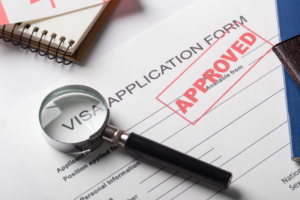Recibir una Solicitud de Evidencia (RFE) del USCIS puede ser intimidante, especialmente cuando su estatus migratorio o petición dependen del resultado. Sin embargo, una RFE no es una denegación. Es una segunda oportunidad para aclarar su solicitud y fortalecer su caso con la documentación correcta.
En Immigration Universe Attorneys, hemos guiado a innumerables clientes a través de este proceso. Nuestro objetivo es ayudarle a comprender qué significa la RFE, cómo responder correctamente y cómo evitar futuros retrasos o denegaciones.
¿Qué es una Solicitud de Evidencia (RFE) del USCIS?
Una Solicitud de Evidencia es una notificación formal del USCIS solicitando documentos o explicaciones adicionales para respaldar su petición de inmigración. Esto significa que el oficial que revisa su caso necesita más pruebas antes de tomar una decisión.
Las RFE se pueden emitir para una amplia gama de solicitudes de inmigración, incluidas peticiones basadas en la familia, visas de empleo y ajustes de estatus.
Algunos ejemplos comunes incluyen:
- Documentos faltantes o vencidos
- Información inconsistente entre formularios
- Falta de evidencia de relación o empleo
- Faltan firmas o traducciones
Razones comunes para recibir una RFE
A continuación se muestra una tabla de referencia rápida para ayudarlo a identificar por qué USCIS pudo haber emitido su RFE y qué tipo de evidencia podría resolverlo:
| Motivo de la RFE | Ejemplos de documentos solicitados | Pruebas de apoyo adicionales |
| Prueba de relación | Acta de matrimonio o de nacimiento | Arrendamiento conjunto, fotos, estados financieros |
| Verificación de empleo | Carta de oferta de trabajo o talones de pago | Formularios de impuestos, cartas de empleadores |
| Apoyo financiero | Declaraciones de impuestos o extractos bancarios | Declaración jurada de apoyo (formulario I-864) |
| Verificación de identidad | Pasaporte o documento de identidad | Traducción certificada si no está en inglés |
Comprender el motivo detrás de la RFE le ayudará a preparar una respuesta precisa y completa.
Cómo leer y comprender su carta RFE
Cada RFE incluye instrucciones específicas y una explicación detallada de lo que falta. Revísela detenidamente y preste atención a:
- Hechos: Lo que USCIS cree que falta o no está claro.
- Ley: La sección de la Ley de Inmigración y Nacionalidad (INA) relevante a su caso.
- Evidencia solicitada: Qué documentos debe proporcionar.
- Fecha límite de respuesta: el número exacto de días que tiene para responder.
Resalte o enumere cada documento solicitado antes de comenzar a reunir materiales.
Paso a paso: Cómo preparar su respuesta a la RFE
Siga estos pasos clave para construir una respuesta sólida y organizada:
- Lea la RFE completa : comprenda cada detalle antes de actuar.
- Haz una lista de verificación : anota cada documento solicitado.
- Recopilar evidencia : asegúrese de que las copias sean claras, legibles y traducidas.
- Escriba una carta de presentación : resuma lo que incluye y cómo respalda su caso.
- Organice su respuesta : coloque los documentos en el mismo orden en que aparecen en la RFE.
- Conserve copias : conserve siempre una copia completa de su respuesta para sus registros.
- Envíelo con seguimiento : utilice correo certificado o un mensajero para confirmar la entrega.
Errores comunes que se deben evitar al responder a una RFE
Evite estos errores frecuentes para evitar retrasos o denegaciones:
- Presentar pruebas incompletas o documentos irrelevantes.
- Enviando su respuesta después de la fecha límite.
- Olvidar las traducciones certificadas de documentos en idiomas extranjeros.
- No incluir una explicación clara y organizada.
Una respuesta bien preparada demuestra a USCIS que usted toma su caso en serio y comprende el proceso.
¿Cuánto tiempo tengo para responder a una RFE de USCIS?
El USCIS generalmente le da 30, 60 u 87 días calendario para responder, según el tipo de caso y si la notificación se envió por correo postal o electrónico. No se conceden prórrogas, así que actúe con rapidez.
Es mejor empezar a trabajar en su respuesta inmediatamente después de recibir la notificación. Esperar demasiado podría dejarle sin tiempo suficiente para reunir las pruebas necesarias.
¿Qué pasa si no responde a tiempo?
Si no responde dentro del plazo, USCIS tomará una decisión basándose en la información que ya tiene. En la mayoría de los casos, esto resulta en la denegación de su petición.
Si se da cuenta de que no puede cumplir con la fecha límite, consulte con un abogado de inmigración lo antes posible. Puede que haya pocas alternativas disponibles, pero el tiempo es crucial.
¿Debería contratar a un abogado de inmigración para su RFE?
Aunque algunos solicitantes intentan gestionar las RFE por su cuenta, trabajar con un abogado de inmigración con experiencia puede marcar la diferencia. Un abogado comprende el lenguaje legal de las RFE, sabe cómo presentar las pruebas eficazmente y se asegura de que su respuesta aborde todas las inquietudes planteadas por el USCIS.
La abogada Ileana Rivera y su equipo de Immigration Universe Attorneys cuentan con amplia experiencia ayudando a clientes a responder a solicitudes de comparecencia (RFE) y reconstruir casos sólidos. Su enfoque personalizado garantiza que sus pruebas estén completas y organizadas estratégicamente.
“Cada RFE es una oportunidad para fortalecer su caso, no el final de su proceso”. – Abogada Ileana Rivera
Prevención de futuros RFE
Puede reducir las posibilidades de recibir otra RFE al:
- Verificar dos veces todos los formularios y archivos adjuntos antes de enviarlos.
- Utilizamos traducciones certificadas para todos los documentos en idiomas extranjeros.
- Siga las instrucciones de USCIS exactamente como están escritas.
- Mantener copias actualizadas de toda la correspondencia anterior.
- Consultar con un abogado autorizado antes de presentar la solicitud.
Para obtener más información sobre asistencia profesional para casos complejos de inmigración, visite nuestra sección de Servicios de Inmigración .
Programe su consulta confidencial
Deje que nuestro equipo le ayude a comprender sus derechos y opciones legales.
Teléfono: +1 (407) 818-1244
Correo electrónico: service@immigration-uni.com Dirección: 7901 Kingspointe Blvd, Ste. 8, Orlando, FL 32819 WhatsApp: +1 (407) 720-8983
Preguntas frecuentes (FAQ)
- ¿Es una Solicitud de Evidencia (RFE) lo mismo que una Notificación de Intención de Denegación (NOID)? No. Una RFE solicita documentos adicionales o aclaraciones, mientras que una NOID indica que el USCIS tiene la intención de denegar su caso a menos que presente una justificación sólida.
- ¿Cuánto tiempo tengo para responder a una RFE de USCIS? Según el tipo de caso, USCIS da 30, 60 u 87 días calendario para responder. La fecha límite es definitiva; no se aceptan solicitudes fuera de plazo.
- ¿Puedo presentar nueva evidencia después de la fecha límite de la RFE? No. USCIS solo considera los documentos recibidos antes de la fecha límite. Cualquier evidencia presentada después será descartada.











